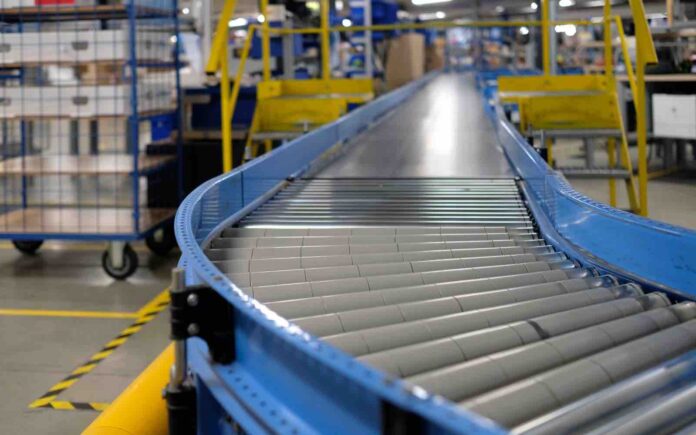In today’s fast-paced world of e-commerce and logistics, warehouses are the heartbeat of the supply chain. Efficiency, speed, and accuracy are paramount, and businesses are continually seeking innovative ways to streamline operations. Enter gravity conveyors – a game-changing solution that is transforming the way warehouses handle inventory. In this blog, we’ll dive into the benefits of gravity conveyors and explore how they can revolutionize your warehouse operations.
What Are Gravity Conveyors?
Gravity conveyors are a type of conveyor system that relies on gravity to move products from one point to another. Unlike powered conveyors that use motors and belts, gravity conveyors use a sloped surface or incline to facilitate the movement of goods. These conveyors come in various forms, including roller conveyors, skate wheel conveyors, and chutes, each designed to cater to different needs and types of products.
Why Gravity Conveyors are important
- Cost-Efficiency
One of the most significant advantages of gravity conveyors is their cost-effectiveness. Without the need for power sources, motors, or complex controls, gravity conveyors are generally less expensive to install and maintain compared to powered systems. This makes them an attractive option for businesses looking to optimize their operations without breaking the bank. - Simplicity and Reliability
Gravity conveyors are straightforward in design, which translates to fewer moving parts and, consequently, fewer opportunities for mechanical failure. Their simplicity also means lower maintenance requirements, making them a reliable choice for high-traffic areas within the warehouse. - Flexibility and Adaptability
Gravity conveyors are incredibly versatile. They can be easily adjusted or reconfigured to accommodate changes in warehouse layout or product types. Whether you need a sloped incline for sorting or a horizontal track for moving items across a station, gravity conveyors can be tailored to meet your specific needs. - Improved Workflow and Efficiency
By utilizing gravity to move products, these conveyors streamline the workflow within the warehouse. Goods move smoothly from one area to another, reducing the need for manual handling and minimizing the risk of injuries. This leads to faster processing times and increased overall productivity. - Reduced Energy Consumption
With no need for electric power, gravity conveyors are a green choice for warehouses looking to reduce their carbon footprint. They help lower energy costs and contribute to more sustainable operations, aligning with the growing emphasis on environmental responsibility.
Types of Gravity Conveyors
- Roller Conveyors
Roller conveyors are one of the most common types of gravity conveyors. They consist of a series of rollers mounted on a frame, allowing products to roll from one end to the other. Ideal for moving boxes or pallets, roller conveyors are durable and can handle a wide range of product sizes and weights. - Skate Wheel Conveyors
Skate wheel conveyors use a series of skate wheels mounted on a frame. They are typically used for lighter products or smaller packages. Their design allows for smooth, easy movement and is particularly effective in applications requiring frequent product changes. - Chutes
Chutes are inclined surfaces that guide products down to a lower level. They are often used for sorting or transferring products between different levels in the warehouse. Chutes are simple yet effective, requiring minimal maintenance and providing a cost-effective solution for gravity-driven movement.
Implementing Gravity Conveyors in Your Warehouse
To make the most of gravity conveyors, consider the following steps for implementation:
- Assess Your Needs
Evaluate your warehouse’s layout, product types, and volume to determine which type of gravity conveyor best suits your requirements. Consider factors such as product size, weight, and handling needs. - Plan Your Layout
Design an efficient conveyor system layout that optimizes workflow and minimizes bottlenecks. Ensure that the conveyor paths align with your storage and picking areas to streamline operations. - Invest in Quality Equipment
Choose high-quality gravity conveyors from reputable manufacturers to ensure durability and performance. Properly designed and constructed equipment will offer reliable service and longer lifespan. - Regular Maintenance
While gravity conveyors require less maintenance than powered systems, it’s still essential to perform regular checks to ensure smooth operation. Inspect rollers, wheels, and frames for wear and address any issues promptly.
Conclusion
Gravity conveyors represent a cost-effective, reliable, and efficient solution for enhancing warehouse operations. By harnessing the power of gravity, these conveyors simplify movement, reduce energy consumption, and improve overall productivity. Whether you’re optimizing an existing system or designing a new warehouse layout, gravity conveyors are a smart investment that can drive significant improvements in your logistics processes.
So, if you’re looking to elevate your warehouse operations and embrace a more streamlined approach, consider incorporating gravity conveyors into your logistics strategy. The benefits are clear – from cost savings to increased efficiency, gravity conveyors are revolutionizing the way warehouses operate and setting new standards for operational excellence.



